Most people want to be productive. We want to do our jobs well and produce quality work. Regardless of the type of work you do, you probably want it to be worth doing. And you want the end result to be a positive accomplishment.
But sometimes it can be hard to be productive. Things can stand in our way and make it difficult to complete, or sometimes even begin, the projects we had planned to do.
Writer Margarita Tartakovsky has been credited with stating,
“Productivity isn’t about being a workhorse, keeping busy or burning the midnight oil…It’s more about priorities, planning, and fiercely protecting your time.”
There’s only so many hours in a day, and our energies can be scattered and pulled in many directions. So what can be done when you’re not as productive as you’d like to be? Let’s take a look at a few common behaviours that may be sabotaging your productivity.
Failure to Set Goals
How can you expect to be productive if you don’t know what you want to do? Without clear, achievable goals, it’s hard to measure progress or feel a sense of accomplishment. Imagine if you were driving your car, but had no goal in sight as to where you were going. If you’re driving randomly, in no particular direction, you’ll likely end up somewhere that’s not of your choosing. So the first step in becoming more productive involves establishing specific goals.
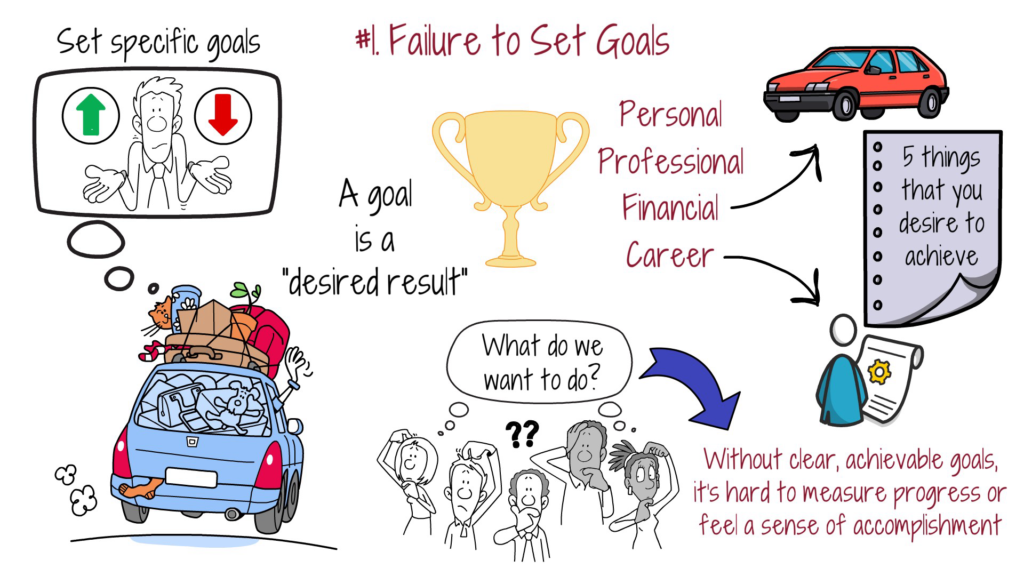
So, what is a goal? How do you achieve it? Of course, there are many kinds of goals: Personal, professional, financial or career goals are a few examples. And then within the general areas, there are specific goals, like particular work projects, a health goal like staying on track with a workout routine, or a financial goal of buying a car, or saving money for a vacation.
According to one common dictionary, a goal can be defined as a “desired result.” So when setting goals, you might start with writing down 5 things that you desire to achieve. Then list the steps you’ll need to take to reach the desired result.
One way to organize the steps you’ll take, is to use the SMART method.
- S=Specific. Be sure you know exactly what your goal is. If you want to save money for a vacation, specify how much you will need to save overall. Then decide exactly how much you will set aside for your vacation each week, rather than just randomly trying to save money when you can.
- M= Measurable. You need to have a way to keep track of your progress. In the scenario of saving money, you can actually see how much you have saved and be able to see where you are on the path to the final goal.
- A= Attainable. Set goals that are realistic to you. It’s okay to challenge yourself, but it still needs to be something that is within your reach. For example, setting a goal to save a certain amount of money will involve assessing your income and establishing a plan to save a realistic amount, and still have enough money to cover your regular expenses.
- R=Relevant. When setting a goal, consider whether it is in sync with your life and other goals. Is this going to help you in other areas of your life and contribute to your overall long term goals?
- T= Time-Specific. A goal should have a deadline. That way you know when you expect to achieve it, rather than just saying “someday.”
Set daily, weekly, and monthly goals to keep yourself engaged and motivated. One way to do this is writing your plan on a calendar. By monitoring your goals on a daily basis, you can keep track of your progress and make adjustments as needed.
One other roadblock to productivity is trying to set too many goals. Once you’ve accomplished certain goals, you can add more. But keep it manageable, so it won’t become overwhelming. Trying to do too much can leave you feeling stuck, not knowing where to start.
Perfectionism
Aiming for high standards isn’t bad, but being overly critical about your work can lead to excessive delays. Perfectionism often results in procrastination and unfinished tasks, because nothing ever feels good enough to be completed. Recognize when it’s time to move on to the next task.
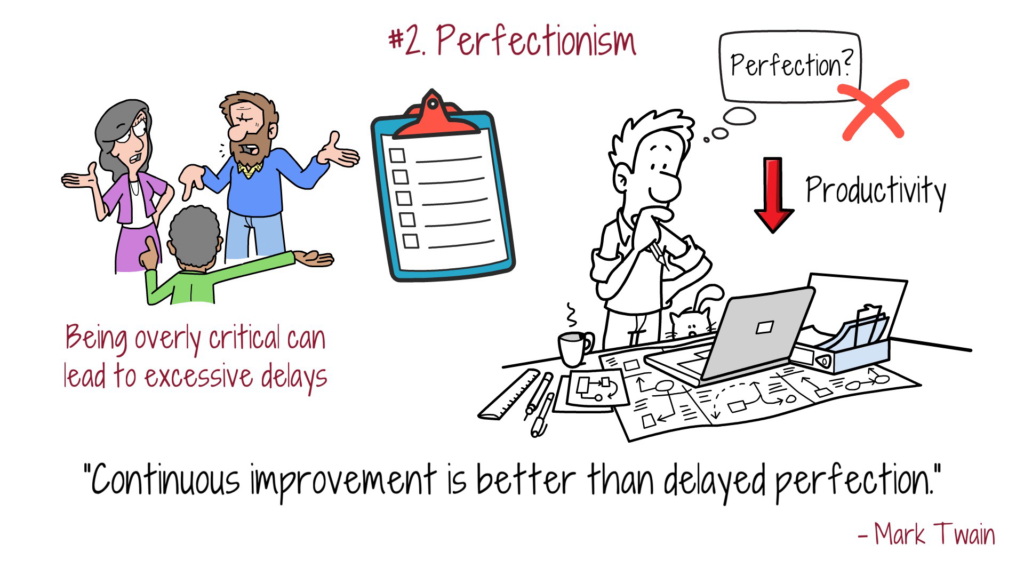
Writer Mark Twain said,
“Continuous improvement is better than delayed perfection.”
If you’re in a stalemate because you are waiting for perfection, your productivity is going to take a hit. If you’ve done your best, then move on. Learn from your mistakes and continually improve your skills. Remember that perfection is never the goal. Done is often better than perfect.
Poor Time Management
Being in control of your time can make a big difference in the rate of your productivity. Without a clear schedule or priorities, it’s easy to waste time or spend it on less important tasks. Scheduling your time also helps you to have realistic expectations and avoid overbooking.
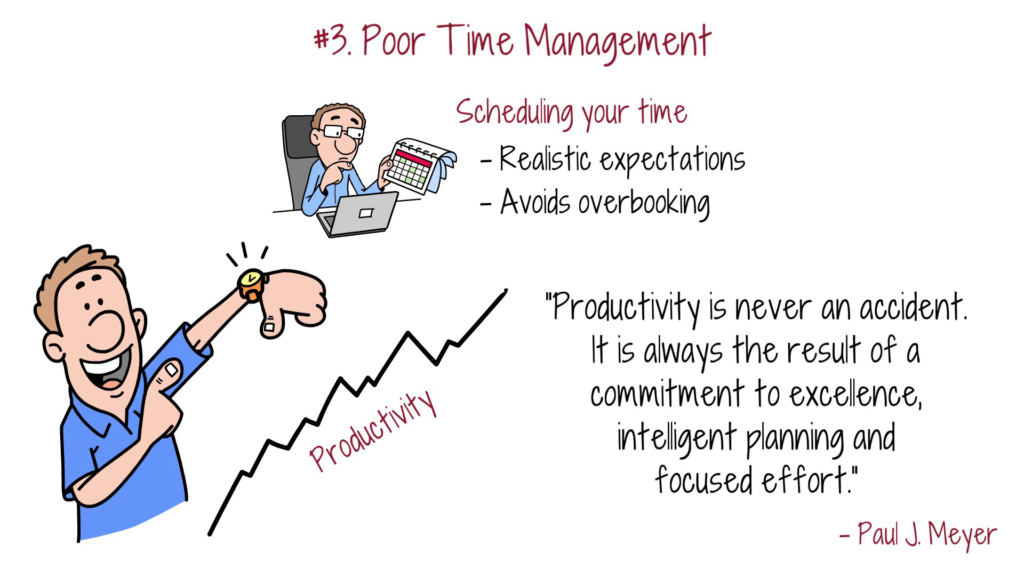
Motivational speaker and author, Paul J. Meyer wrote,
“Productivity is never an accident. It is always the result of a commitment to excellence, intelligent planning and focused effort.”
If you have already identified your goals and the steps you need to take to achieve them, then follow that plan to determine the course of your day. You can be more productive when you already have the day outlined on your schedule. Begin by identifying the top three tasks that need your attention and allocate specific times to focus on them.
Leave a few open slots in your daily calendar for those unexpected situations and tasks that pop up unannounced. You can incorporate the extra things into your day without taking away from your overall goals.
While planning your schedule, be sure to include break times. Skipping breaks might seem like a good way to get more done, but it can actually lead to burnout and decreased productivity. Regular short breaks, especially with physical movement or a change of scenery, can boost your energy and focus for longer periods.
Multitasking
Switching between tasks can lead to more errors and less focus. Focus on one activity at a time and your work quality and efficiency can improve dramatically.
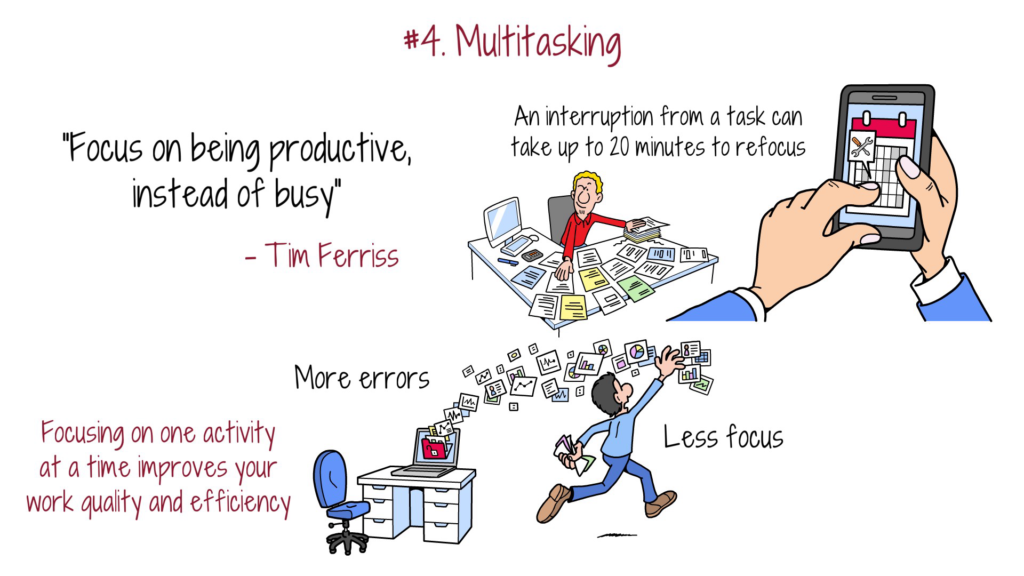
This is where having a schedule and using time management tools to achieve your goals can be helpful. When you are interrupted from a task, it can take up to 20 minutes to refocus and get back on track. If that happens continually all day, you might find yourself starting a lot of different projects, and not finishing any of them.
“Focus on being productive, instead of busy”
– Tim Ferriss
When you have too many things keeping you “busy”, it’s hard to focus on being productive.
Letting Your Emotions Get the Best of You
When you’re not taking care of your mental health, it can be difficult to get anything done. Stressful situations and drama can overwhelm your thoughts and make it hard to focus.
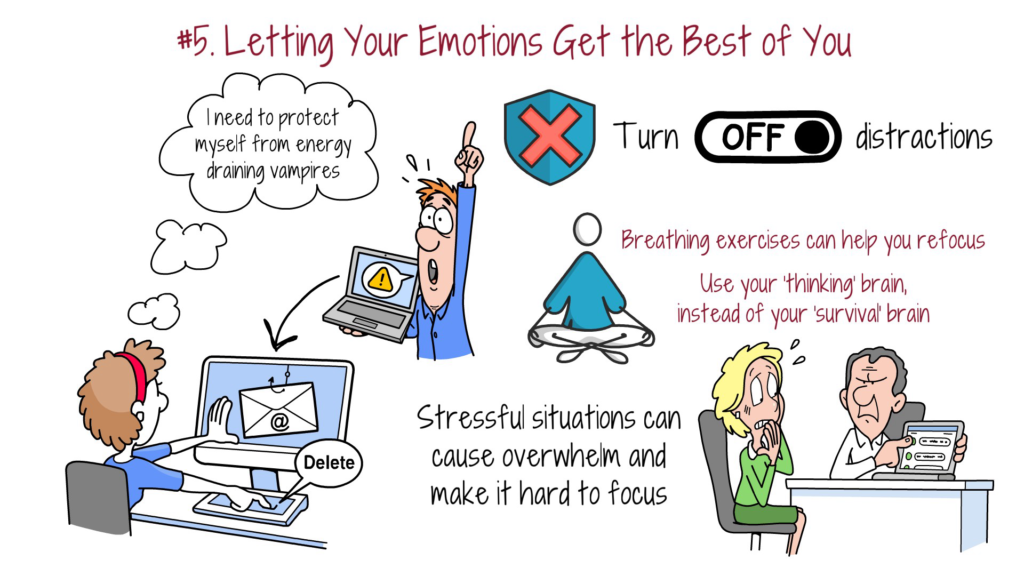
Keep a calm mind so you can actually think. If you find yourself being drawn into other people’s dramas, be mindful of protecting yourself from energy draining vampires that can leave you both physically and emotionally depleted. It’s hard to be productive when you’re distracted with things that are unrelated to the project you’re trying to finish.
Breathing exercises are one way to help you refocus. Then you can use your thinking brain, instead of being stuck in your survival brain. Turn off and shut out distractions that aren’t helping you achieve your goals, keeping in mind that there are some things you can control, and some things you can’t. Make decisions and take appropriate actions to preserve your peace of mind.
Final Thoughts
The feeling of accomplishment you get when you are productive is a good thing. But when you’re not doing as well as you’d like, examine the behaviours that might be holding you back. Think about where you need to make changes.
Artist Pablo Picasso said,
“Action is the foundational key to all success.”
In order to be more productive, using a few simple tips can help you to get going.
Set reasonable, attainable goals, manage your time, and stay on track. You may find your level of productivity will spring back to life!
